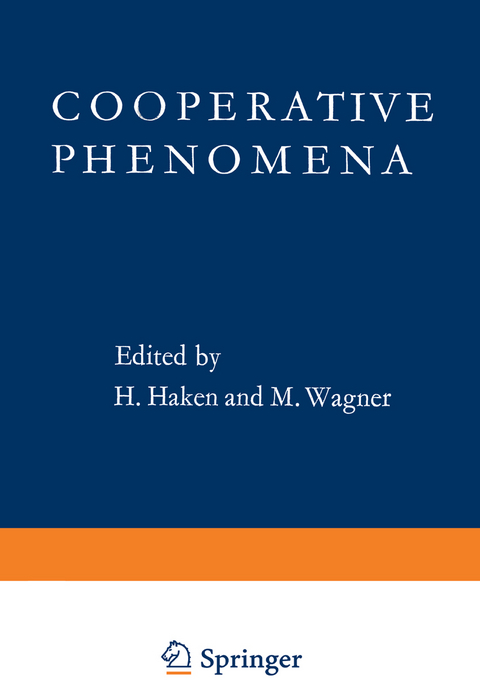
Cooperative Phenomena
Springer Berlin (Verlag)
978-3-642-86005-8 (ISBN)
I. Quasi-particles and their Interactions.- Specific Editorial Introduction.- a) Some Problems about Polarons in Transition Metal Compounds.- b) Light Absorption by Electrons in Polar Crystals in a Strong Magnetic Field.- c) Properties of Crystals at High Concentration of Excitons.- d) Some Steady State Effects Associated with Electric Currents in Semiconductors.- e) The Free Energy and Dynamical Structure Factors of a Metallic System.- II. Superconductivity and Superfluidity.- Specific Editorial Introduction.- a) Electron-phonon Interactions and Superconductivity.- b) The Mechanism for Superconductivity-Twenty-Two Years Later.- c) Transition Temperatures of Superconductors.- d) The Effect of Stress on the Superconductivity of Tin.- e) Aspects of Condensation in 4He II.- f) The Derivation of Time-Dependent Ginzburg-Landau Equations in Superfluids.- g) Scattering of 4He Atoms by the Surface of Liquid 4He.- III. Dielectric Theory.- Specific Editorial Introduction.- a) Some Comments on the Dynamical Dielectric Constants.- b) Vibrational Absorption and Electronic Deformation in Solids.- c) Electrically Induced Stresses in Dielectric Fluids.- d) Dielectric Constant of Alkali Halide Crystals Containing OH? Substitutional Impurities.- IV. Reduced Density Matrices.- Specific Editorial Introduction.- a) Hypothetical Infinite Series Expressions of Reduced Density Matrices.- b) Towards a Generalized Ginzburg-Landau Equation.- c) Bose Condensation and Superfluid Hydrodynamics.- V. Phase Transitions.- Specific Editorial Introduction.- a) The Description of Thermodynamical Phases in Statistical Mechanics.- b) The Effect of Interatomic Potential on the Feature of Solid-Liquid Phase Transition.- c) The Effect of a Magnetic Field on Impurity Conduction in Semiconductors.- d)Relaxation Measurements on Single Crystals of MnCl2 · 4 H2O and MnBr2 · 4 H2O Near the Magnetic Phase Transition.- VI. Many-body Effects.- Specific Editorial Introduction.- a) The He Monolayer on Graphite.- b) Comments on Statistical Model and Collective Modes of Nuclei.- c) Classical Aspects of Spontaneous Emission.- d) Experiments and Theoretical Considerations Concerning the Dual Nature of Light.- e) Divergent Integrals in Scattering Theory.- f) Perturbation Methods and Lagrange's Expansion.- g) A Simple Lagrangian Formalism for Fermi-Dirac Quantization.- VII. Synergetic Systems.- Specific Editorial Introduction.- a) Synergetics-Towards a New Discipline.- b) Irreversibility and Dissipativity of Quantum Systems.- c) On the Possibility of Transport-Phase-Transitions in Phonon Systems.- d) Search for Cooperative Phenomena in Hydrogen-Bonded Amide Structures.- e) Behaviour of Interacting Protons: The Average-Mass Approach to their Study and their Possible Biological Relevance.- f) Ion Transport Across Cell Membranes.- g) Physical Relationships in Architecture.- VIII. Biographical and Scientific Reminiscences.- a) Biographical Notes.- b) Erinnerungen an die gemeinsame Arbeit mit Herbert Fröhlich.- c) Superconductivity and Superfluidity.- d) Some Reminiscences of Research in Liverpool in 1950.- e) Bibliographical Notes.
| Erscheint lt. Verlag | 21.4.2012 |
|---|---|
| Zusatzinfo | XVI, 458 p. |
| Verlagsort | Berlin |
| Sprache | englisch |
| Maße | 170 x 244 mm |
| Gewicht | 813 g |
| Themenwelt | Naturwissenschaften ► Chemie ► Analytische Chemie |
| Naturwissenschaften ► Physik / Astronomie ► Allgemeines / Lexika | |
| Naturwissenschaften ► Physik / Astronomie ► Atom- / Kern- / Molekularphysik | |
| Naturwissenschaften ► Physik / Astronomie ► Festkörperphysik | |
| Schlagworte | Atom • atoms • Crystal • Dielektrikum • Dynamics • electron • Electrons • Fröhlich, Herbert • Hydrodynamics • Hydrogen • Mechanics • Phasenumwandlung • phase transition • Quantum Theory • Quasiteilchen • scattering • semiconductor • Statistical Mechanics • Superconductivity • Superflüssigkeit • Supraleitung • Synergie |
| ISBN-10 | 3-642-86005-2 / 3642860052 |
| ISBN-13 | 978-3-642-86005-8 / 9783642860058 |
| Zustand | Neuware |
| Haben Sie eine Frage zum Produkt? |
aus dem Bereich


